 |
The prime scientific objective of the RPC instruments package
is to study, in situ, the plasma and wave environment of a
comet and its interaction with the dust and gas materials,
from the onset of activity beyond 3.5 AU to magnificence at
perihelion. The Rosetta mission will allow plasma physicists
to investigate for the first time the innermost regions of
the coma and in particular the region inside the contact surface
that was just skimmed by the Giotto probe. The contact surface
forms at the distance where the solar wind ram pressure equals
the cometary thermal plasma pressure, whenever the gas production
rate is sufficient. This boundary also prevents the inner
part of the coma to be reached by the interplanetary magnetic
field perturbed by the presence of the extremely large comet
environment. If the gas production is restricted to a small
numbers of active regions, as shown from the Vega and Giotto
observations of comet Halley's nucleus, strong asymmetries
will occur. One objective of the RPC is to describe and understand
the local and temporal effects of the nucleus activity on
the coma structure and dynamical behaviour.
To achieve these scientific objectives, five instruments
have been selected to measure the ion and electron distribution
functions, the ion composition, the electron density and temperature,
the plasma drift velocity, the magnetic field, and the natural
waves up to 3.5 MHz. The wide range of plasma parameters expected
all along the Rosetta mission implies the instrument capabilities
to be as large as possible. This has been taken into consideration
by the RPC proposers. Moreover, to be able to save mass and
power spacecraft resources, and to have got a single interface
to the spacecraft, the RPC consortium has been formed. It
therefore includes the five sensors described below, the common
interface, and general ground support equipment.
| Ion Composition Analyser
(ICA) |
The Ion Composition Analyser measures the distribution function
of positive ions. The instrument resolves the 3-D velocity
distribution of cometary and solar wind ions, with a mass
resolution high enough to resolve the major species such as
protons, helium, oxygen, molecular ions, and heavy ions clusters
(dusty plasma). The 2.0 kg instrument consists of an electrostatic
arrival angle filter, an electrostatic energy filter, and
a magnetic momentum filter. Particles are detected using a
large diameter (100 mm) microchannel plate and a 2-D anode
system. ICA has its own processor for data reduction/compression
and formatting.
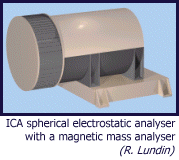
|
The ICA is provided by the Swedish Institute of Space
Physics, Sweden.
Principal Investigator: R. Lundin.
|
| Ion and Electron Sensor
(IES) |
The Ion and Electron Sensor consists of two electrostatic
analysers, one each for electrons and ions, which share a
common entrance aperture. The charged particle optics for
IES employ a toroidal top-hat geometry along with electrostatic
angle deflectors to achieve an electrostatically scanned field
of view of 90 x 360 degrees. The large field of view will
be used to measure the ions and electrons of the solar wind,
ions and electrons in the cometary coma, and sputtered ions
and photoelectrons generated on the cometary nucleus.
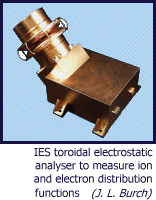
|
The IES is provided by the Southwest Research Institute,
Texas.
Principal Investigator: J. Burch
|
| Langmuir probe Instrument
(LAP) |
The dual Langmuir probe instrument has as its prime objectives
to study the plasma density, temperature and flow velocity.
It comprises two spherical sensors mounted at the tip of the
deployable booms, and the sensors can be swept in potential
to measure the current-voltage characteristic which provides
information on the electron number density and temperature.
The probes can be held at a fixed bias potential to measure
plasma density fluctuations from structures in the plasma,
and by a time-of-flight analysis of the signals from the two
probes the plasma flow velocity is determined. In the inner
coma we expect a close coupling to the neutral gas, and the
measurement thus provides information on the neutral gas flow.
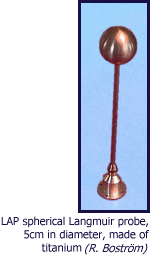
|
The LAP is provided by the Swedish Institute of Space
Physics, Sweden.
Principal Investigator: R. Boström
The LAP Homepage at the Swedish Institute of Space
Physics
|
| Fluxgate Magnetometer
(MAG) |
The MAG experiment aims to measure the magnetic field in
the interaction region between the solar wind plasma and the
comet. It consists of two ultra light (about 28g each) triaxial
fluxgate magnetometer sensors mounted close to the tip of
the spacecraft boom pointing away from the cometary nucleus
and about 10 to 30 cm closer to the spacecraft body (see Fig.
4). Two sensors are required to minimize the influence of
the spacecraft magnetic field and for redundancy reasons.
The measurement range is +/- 16,384 nT with steps of +/- 0.031
nT. They will be operated with a high time resolution of about
50 vectors/s, the achieved bandwidth is thus 0-25 Hz. These
performances will allow detailed analysis of magnetic field
variations. RPC/MAG is furthermore designed to study possible
remnant magnetic field of the nucleus, measurements done in
close cooperation with the lander magnetometer experiment
ROMAP.
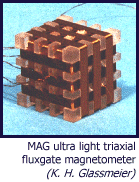
|
The MAG is provided by the Institute of Geophysics
and Meteorology, Technical University of Braunschweig
Germany.
Principal Investigator: K. Glassmeier
|
| Mutual Impedance Probe
(MIP) |
The Mutual Impedance Probe will measure the aeronomical parameters,
electron density and temperature, as well as plasma flow velocity
in the inner coma. In addition, MIP will investigate natural
waves in the 7 kHz-3.5 MHz frequency range and monitor the
dust and gas activity of the nucleus. A light electrical sensor
made of fibre carbon and an electronics board makes up the
MIP instrument. The MIP performance has the virtue of being
independent of the chemical composition and photoemissive
properties of its electrodes and is immune from contamination
by dust and ice deposits. The extremely low energetic plasmas
expected within the contact surface can then be explored.
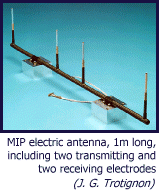
|
The MIP is provided by the Laboratoire de Physique
et Chimie de l'Environnement, France.
Principal Investigator: J. Trotignon
The Rosetta/MIP Homepage at the Centre National de
la Recherche Scientifique
|
| Plasma Interface Unit (PIU) |
The Plasma Interface Unit is the interface between the five
instruments above and the spacecraft. Click here to find out
more about it.
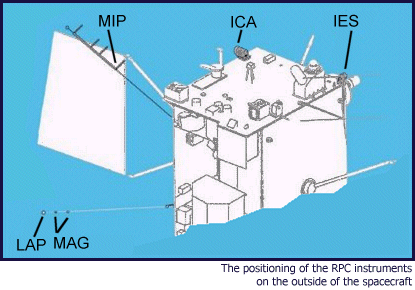
| The PIU is provided by the Imperial College of Science,
Technology and Medicine, England. |
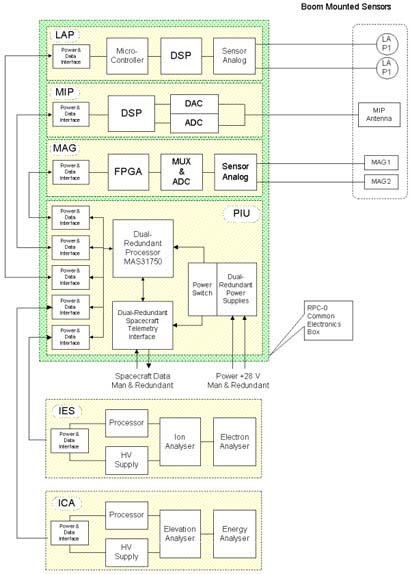
This page was last updated September 2002.
|







